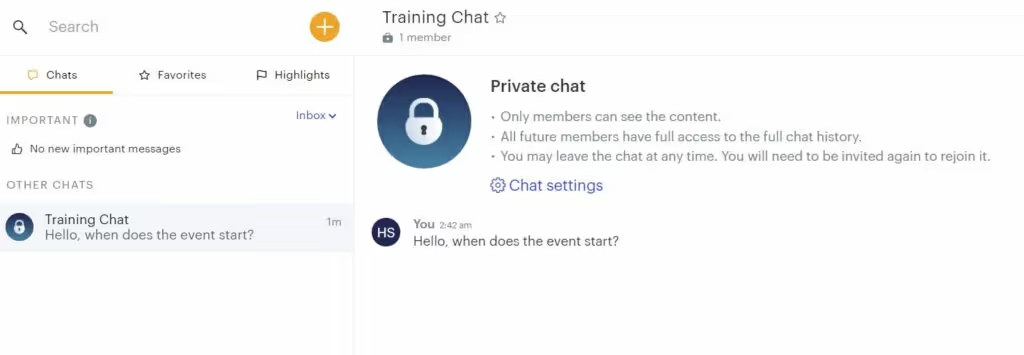Effective communication is the glue that holds all your employees together. It unites everyone, from the top management to the frontline and remote workers, towards a shared set of organizational goals and values.
Yet a recent study paints a grave picture of most working environments. 80% of professionals rate their business’ communication as poor or average.
And when kept unchecked, ineffective communication often leads to a snowball effect of disengagement and confusion.
It doesn’t have to be this way. Implementing effective organizational communication strategies is the key to unlocking smooth coordination among your employees. And in this post, we’ll take a look at what those strategies are.
Why organizational communication is important
In a recent report called "Internal Communication in the Eyes of C-Suite Leaders", it was found that C-suite executives recognized the vital role internal communication plays in improving their bottom lines and driving business results. And rightly so.
Workers need to interact and exchange information and documents with one another frequently. Plus, they want the top management to listen to their concerns, suggestions, and feedback.

The same goes for senior leaders in the company. They want to make sure that internal marketing campaigns, critical company announcements, news about employee benefits, and other important messages are reaching each and every member of the workforce.
By fulfilling these needs for both parties, a good corporate communication strategy solidifies the bond among the workers and facilitates the sharing of information. The result? A big boost in employee engagement and productivity.
Now the question is, how can you level up your company’s communication? By following the most effective organizational communication strategies.
Organizational communication strategies in the workplace
Without further ado, here are our best organizational communication strategies to help resolve workplace conflicts and facilitate a smooth exchange of information across your company.
1. Create a corporate communication plan
Failing to plan is planning to fail. If you don’t have an internal communication plan in place, drop everything else and build one first. Without a plan, you won’t have a clear roadmap to implement effective communication in your business.
A great communication strategy will help you answer vital questions like:
- How to make your messages more relevant and engaging?
- Which communications channels should you be using?
- How can you ensure the right content reaches the workers at the right time?
- What roles will your C-level executives play in workplace communication?
- How will you encourage employees to engage in two-way conversations?
The planning process starts with having a clear understanding of your communication goals and audience. And then conducting an audit of the current communication campaigns and channels you have in place.
This is followed by determining your communication schedule and channels for the next six or 12 months. To learn more, check out our in-depth guide on building an internal communication strategy.
2. Encourage one-to-one conversations
Not every concern can be appropriately discussed in a group setting. For example, you may want to address a personal grievance or performance issue. And in such cases, it’s much better to initiate a private chat.
A one-on-one meeting gives you the chance to read the worker’s body language, know their communication style, and get visual cues on how to proceed with the interaction.
Even when you don’t have a specific issue to discuss, setting aside one-to-one time with your employees on a regular basis is essential. Because it helps you understand and bond with them more effectively. So make sure to add this company communication strategy to your arsenal.
3. Sprinkle a little humor
Workplace communication is usually a serious endeavor. You often convey information that’s intense. Whether you’re discussing a problem or setting goals, laughing and cracking jokes may seem out of place.
But a series of serious interactions can put workers in a negative mindset. And it affects how they interpret and draw conclusions from the information shared with them. When a meeting gets too heated, people want to leave as soon as possible, which hinders the flow of information.
Although it’s not always possible to avoid a stressful conversation, levity can help you a lot in pushing your company’s communication strategy forward. Lightening the mood is an important skill that helps you defuse tense situations and relax everyone involved in the communication.
So the next time you’re communicating something to your employees, try to make them laugh.
Also, if you’re worried that your jokes won’t be any good, then you’re focusing on the wrong thing. It’s not so much about making clever remarks as about trying to make people feel relaxed and comfortable. In fact, research shows that people welcome any kind of levity as long as it’s not offensive or hurtful.
4. Nurture two-way communication
Effective communication is supposed to be a two-way street. An organization cannot reach its full collaboration potential if information flows only in one direction — from top management to the rest of the workers.
If employees can’t ask questions or discuss the information conveyed, then you aren’t communicating. You’re commanding. You’re giving orders and expecting workers to follow them.
Of course, some directives are absolute and non-negotiable. But you can’t rely on this approach all the time when working with today’s skilled, talented professionals who thrive in an environment of autonomy.
Instead, the right company communication strategy is to invest in creating a receptive space where workers can put forth their concerns, share suggestions, and feel heard. And make sure those inputs are acted on. Not brushed under the carpet.
Listening to feedback doesn’t just help your employees feel valued. It also helps you clarify your message. You may think your communication is crystal clear but still miss some aspects critical to help others understand the information. Two-way communication can fill those gaps.
Facilitating two-way communication in your organization is easier than you think. For example, Blink is a corporate communication app that comes with a social-media-style news feed visible to all employees.
.png)
Anyone in the company can post an update, on which others can like and comment. This helps the most relevant stories rise to the top. Plus, the admins can choose to amplify selected updates even further.
5. Bring consistency in your communication
All your communication, whether written or verbal, and whether internal or external, should have the essence of your company’s brand and workplace culture.
Plus, it should have a unique, consistent voice that reduces any chance of ambiguity and unifies your workforce. Such a voice also helps you communicate in the right spirit, not to mention avoid conflicts and misunderstandings.
But the more people participate and contribute to your organization’s communication, especially from different locations and time zones, the harder it gets to keep the voice consistent.
So what you need is a set of shared guidelines, formats, and best practices that everyone can refer to when creating content. And you can prepare the same in the form of a communication style guide.
Once you’ve clearly laid out your communication guidelines, make sure to train your communication department, as well as other contributors, on how to put the instructions into practice for subsequent messages.
6. Make use of visual aids
Different people have different learning styles. Some are comfortable reading pages after pages of text, some want to listen on the go, while others need something to view, like a video.
Regardless, almost everyone gets enticed by imagery. Presentations and infographics help people wrap their heads around the given information. So using colorful posters, charts, and graphs to distill complicated ideas is one of the best ways to make your message clear and memorable.
There are many ways to use visual aids for workplace communication. For example, if you find yourself repeating certain messages to your staff, or answering the same questions again and again, you can save time and effort with a visual aid to share the corresponding content.
Is someone in your ear every 10 minutes with questions about holidays? Design a holiday calendar workers can check on their own. Bombarded with requests about printer passwords? Print them in large letters and stick them near the machine.
You don’t need to be a master designer to do this. Tools like Canva, Piktochart, and Venngage come with drag-and-drop functionality and hundreds of ready-made templates designed by professionals. So all you need to do is pick a template and replace its contents with yours.
7. Train your staff on effective communication
We have spent a good chunk of our lives communicating with others, but that doesn’t necessarily mean that we’re good at it.
For example, many employees have such a logical, fact-based communication style that they often forget to take others’ emotions into account. Others often get carried away by feelings and miss key details. And the gaps in communication lead to conflict, ambiguity, and workplace politics.
So in any organization, effective communication should be proactively taught and encouraged. And it should be a vital part of the training programs you have in place for workers.

Great communication training helps teach your employees how to keep their emotions in check and present their ideas clearly and comprehensively.
8. Conduct more open sessions
Meetings are seen as a dull affair, especially when just one or two people are doing most of the talking. You’ve probably sat through many where you were just expected to attend and listen.
But that doesn’t mean all meetings are bad. A meeting is just a tool. And like any other tool, you can handle it effectively or poorly.
So every once in a while, you should conduct an open session with all the workers in your company or in specific departments. This meeting will have a set agenda, and every employee will be encouraged to speak up and talk about their work, their experiences, and any concerns or suggestions.
Scheduling such open sessions regularly will not just improve communication, but also help you get a pulse of different teams and your overall culture.
9. Leverage the right tools and technology
Remote work, dispersed teams, smartphones, and other advancements are shaping the new reality of work. But in many organizations, the communication systems and processes haven’t caught up to this change.
The good news is modern technology and employee engagement tools have made it easier than ever to streamline internal communication and include every employee in the process, from hiring to global HR services.
Frontline workers, for example, have largely been excluded from communication channels available to desk-based employees, such as email and instant messaging. With the rise of smartphones and mobile apps though, it is now possible to make them a crucial part of your ongoing communication.
With Blink, for example, workers can easily share documents, engage in live chat with one another, and resolve problems fast.

So it’s time for you to see if the technology you have in place is really enough to get the job done. If not, invest in the right tools to take your communication to the next level.
10. Cultivate the habit of active listening
No doubt, writing and talking clearly are crucial for proper communication, but managers and other employees should also know how to listen.
Poor listening undermines communication and defeats the purpose of effective collaboration. Without the right listening skills, messages are more likely to be misunderstood.
Now, you may think you listen, but good listening is more than identifying others’ words. As Stephen Covey says, “Most of us listen with the intent to respond, not to understand.”
So, cultivate a habit of listening among yourself and your employees. Encourage everyone to practice active listening methods. And teach your staff to reflect, summarize, and ask clarifying questions when listening to a customer or coworker.
When employees and customers feel heard and understood, they’re more likely to keep working with you and have a positive image of your brand.
How to improve organizational communication in the workplace
Follow these tips to help achieve effective communication in the workplace:
- Use the right tools. Having the right tools to communicate, that everyone can access, and use is vital. Review your tech stack and make improvements where needed.
- Get feedback. Employee surveys can help shed light on your current communication methods and where you can make improvements.
- Use different communication formats. Images, emails, videos, the list goes on. Use different formats for the different types of communications you need to deliver.
- Distribute through the right channels. What's the best way to deliver the message? Email, instant message, intranet, app notifcation? Make sure you pick the right channel.
- Focus on employee engagement strategies. An engaged workforce is open to communication and sharing their voice.
- Measure the outcomes. Keep a close eye on your metrics. How many people are reading your emails and communications? Is it enough or do you need to improve?
Communication Strategies in the Workplace FAQs
What are some communication strategies in the workplace?
Some effective communication strategies include:
1. Encouraging 1-1 conversations
2. Using the right tools for your organization
3. Being consistent in your communication
4. Have face to face meetings
5. Encourage open, two way conversations
What are the 4 ways of workplace communication?
The four main types of workplace communication are: verbal, body, phone and written. You and your staff will be exposed to one, if not all, of these types throughout the work day.
What are 3 tips for effective communication?
Effective communication is the sum of quite a few parts, but 3 mains tips would be:
1. Actively listen - Really listen to what the person is saying, and remember key points
2. Ask open questions - Keep the conversation going, and invite the person to freely say what's really on their mind
3. Accept they may disagree with you - It may not all be smooth sailing, and they may disagree with you, don't take it personally, try to understand their point of view.
Wrapping up: effective organizational communication strategies
As you can see, good communication doesn’t happen by accident. You need to make sure that your messages successfully reach the intended audience, are interpreted clearly, and are understood empathetically.
It takes effort from both you and your staff. So the more confidently you apply the organizational communication strategies we have outlined in this guide, the more your team would also integrate them into their actions. So take time to develop and execute these concepts diligently to build a collaborative and efficient workplace.
And remember, using a communication solution like Blink can reduce your communication effort while increasing the penetration of your messages, even with a largely remote or dispersed workforce. Book a free demo today.

